OUR SCIENCE
Publications
2020

BioRxiv
CUB and Sushi Multiple Domains 1 (CSMD1) Opposes the Complement Cascade in Neural Tissues
Baum, Matthew L., Daniel K. Wilton, Allie Muthukumar, Rachel G. Fox, Alanna Carey, William Crotty, Nicole Scott-Hewitt, Elizabeth Bien, David A. Sabatini, Toby Lanser, Arnaud Frouin, Frederick Gergits, Bjarte Håvik, Chrysostomi Gialeli, Eugene Nacu, Anna M. Blom, Kevin Eggan, Matthew B. Johnson, Steven A. McCarroll, Beth Stevens
This preprint manuscript describes the complement inhibitory capacity, and loss-of-function synaptic pruning phenotypes of CSMD1, a protein that inhibits C4’s function in the complement cascade and is encoded by a schizophrenia risk locus.
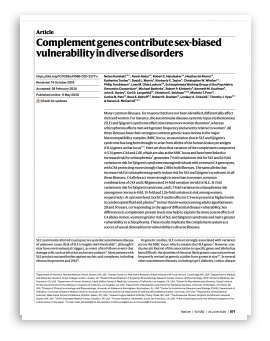
Nature
Complement Genes Contribute Sex-Biased Vulnerability in Diverse Disorders
Kamitaki, Nolan, Aswin Sekar, Robert E. Handsaker, Heather de Rivera, Katherine Tooley, David L. Morris, Kimberly E. Taylor, Christopher W Whelan, Philip Tombleson, Loes M Olde Loohuis, Schizophrenia Working Group of the Psychiatric Genomics Consortium; Michael Boehnke, Robert P Kimberly, Kenneth M Kaufman, John B Harley, Carl D Langefeld, Christine E Seidman, Michele T Pato, Carlos N Pato, Roel A Ophoff, Robert R Graham, Lindsey A Criswell, Timothy J Vyse, Steven A McCarroll
This paper elucidates the differential risk profiles arising from C4 locus genetic variation for men and women, and the complex relationships between C4A-related risk for schizophrenia versus autoimmune disorders such as lupus. The McCarroll lab also presents here foundational data on complement component C3 and C4 protein levels in the CSF across the lifespan of healthy adults, demonstrating that sex and age effects, in addition to C4 genotype, are highly significant covariates in any consideration of complement as fluid biomarkers. Finally, this paper also describes a computational method and data resource for imputing C4 genotypes from SNP data, which will be highly useful in a variety of research and translational contexts considering the complex influence of C4 variation on complement expression and disease risk.
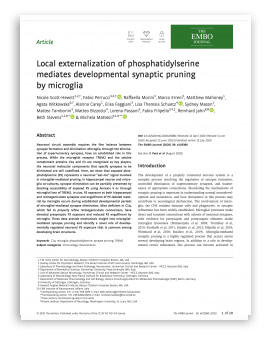
The EMBO Journal
Local Externalization of Phosphatidylserine Mediates Developmental Synaptic Pruning by Microglia
Scott-Hewitt, Nicole, Fabio Perrucci, Raffaella Morini, Marco Erreni, Matthew Mahoney, Agata Witkowska, Alanna Carey, Elisa Faggiani, Lisa Theresia Schuetz, Sydney Mason, Matteo Tamborini, Matteo Bizzotto, Lorena Passoni, Fabia Filipello, Reinhard Jahn, Beth Stevens, Michela Matteoli
This paper describes regulation and consequences of phosphatidylserine exposure on neuronal and synaptic membranes, which may serve to recruit or regulate complement activity at synapses and their downstream phagocytosis by microglia.
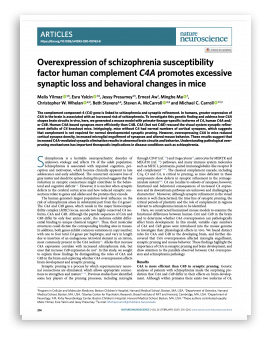
Nature Neuroscience
Overexpression of Schizophrenia Susceptibility Factor Human Complement C4A Promotes Excessive Synaptic Loss and Behavioral Changes in Mice
Yilmaz, Melis, Esra Yalcin, Jessy Presumey, Ernest Aw, Minghe Ma, Christopher W. Whelan, Beth Stevens, Steven A. McCarroll, and Michael C. Carroll.
This paper presents a comprehensive analysis of the impact of human C4A and C4B expression and dosage effects in humanized mouse models. hC4A and hC4B display differences in synaptic tagging and downstream phenotypes, consistent with the differential schizophrenia risk profile of these isotypes. Overexpression of hC4A results in increased synaptic pruning by microglia, altered circuit development, and changes in behavior. These results strongly support a role for neuroimmune mechanisms in prefrontal circuit development and psychiatric vulnerability, and advance the pruning hypothesis of schizophrenia.
2019
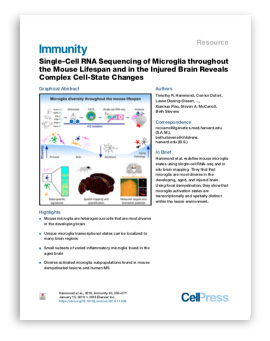
Immunity
Single-Cell RNA Sequencing of Microglia throughout the Mouse Lifespan and in the Injured Brain Reveals Complex Cell-State Changes
Hammond TR, Dufort C, Dissing-Olesen L, Giera S, Young A, Wysoker A, Walker AJ, Gergits F, Segel M, Nemesh J, Marsh SE, Saunders A, Macosko E, Ginhoux F, Chen J, Franklin RJM, Piao X, McCarroll SA, Stevens B
We analyzed the RNA expression patterns of more than 76,000 individual microglia in mice during development, in old age, and after brain injury. Our analysis uncovered at least nine transcriptionally distinct microglial states, which expressed unique sets of genes and were localized in the brain using specific markers.
2018
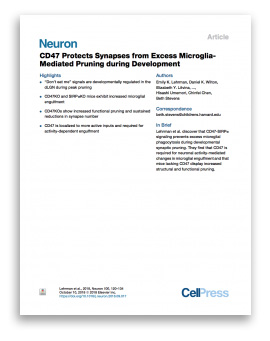
Neuron
CD47 Protects Synapses from Excess Microglia-Mediated Pruning during Development
Lehrman EK, Wilton DK, Litvina EY, Welsh CA, Chang ST, Frouin A, Walker AJ, Heller MD, Umemori H, Chen C, Stevens B
Here, we demonstrate that an innate immune signaling pathway protects synapses from inappropriate removal. The expression patterns of CD47 and its receptor, SIRPα, correlated with peak pruning in the developing retinogeniculate system, and mice lacking these proteins exhibited increased microglial engulfment of retinogeniculate inputs and reduced synapse numbers in the dorsal lateral geniculate nucleus. In addition, CD47 was found to be required for neuronal activity-mediated changes in engulfment, as microglia in CD47 knockout mice failed to display preferential engulfment of less active inputs.
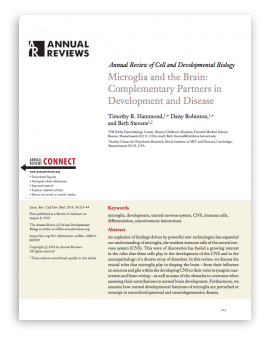
Annual Review of Cell and Developmental Biology
Microglia and the Brain: Complementary Partners in Development and Disease
Hammond TR, Robinton D, Stevens B.
In this review, we discuss the crucial roles that microglia play in shaping the brain – from their influence on neurons and glia within the developing CNS to their roles in synaptic maturation and brain wiring – as well as some of the obstacles to overcome when assessing their contributions to normal brain development. Furthermore, we examine how normal developmental functions of microglia are perturbed or remerge in neurodevelopmental and neurodegenerative disease.
2016
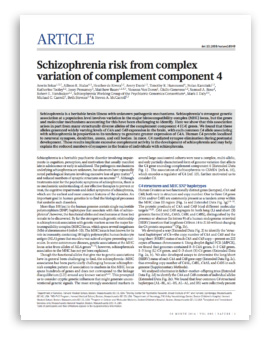
Nature
Schizophrenia risk from complex variation of complement component 4
Sekar A, Bialas AR, de Rivera H, Davis A, Hammond TR, Kamitaki N, Tooley K, Presumey J, Baum M, Van Doren V, Genovese G, Rose SA, Handsaker RE, Schizophrenia Working Group of the Psychiatric Genomics Consortium, Daly MJ, Carroll MC, Stevens B, McCarroll SA.
The results implicate excessive complement activity in the development of schizophrenia and may help explain the reduced numbers of synapses in the brains of individuals with schizophrenia.